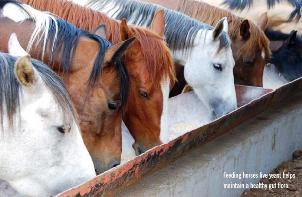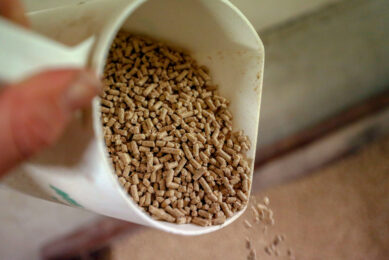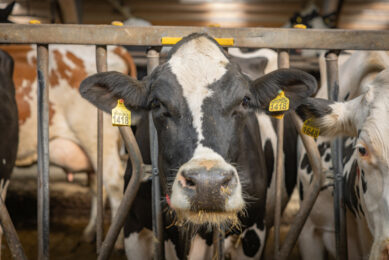Balancing the equine hindgut flora with live yeast

Like the ruminant, the horse has evolved to be able to use grass and forages as a source of food due to the presence of fibre digesting organisms in its gut. It is therefore important to maintain a stable microbial population to ensure healthy gut function. This may be achieved by using live yeast in the diet which can improve the gut environment, promote the growth of fibre-digesting microbes, stabilise the normal flora and reduce the incidence of hindgut acidosis.
The equine gut (Figure 1) contains a diverse array of microbes, including bacteria, protozoa, anaerobic fungi, archaea and bacteriophages, all of which work together to aid feed and fibre digestion for their host. Compared to the rumen, little research has been conducted on the microbes present in the caecum of the horse. However, the limited data that is available has shown many of the microbes are genetically related to, and carry out similar roles to their ruminant counterparts. Any disruption or sudden changes in the balance of the microbial composition can have far-reaching consequences for host health and performance.
Microbes found in the equine gut
Anaerobic fungi have been isolated from the equine gut. They play an important role in aiding fibre digestion by colonising the fibre particle and using their hyphae to help pull the particle apart, allowing the bacteria to access and colonise more quickly. Hindgut acidosis or any drop in the hindgut pH can reduce the growth and activity of the fungi and consequently impair fibre digestion. Ciliate protozoa tend to be more abundant in the colon than the caecum and microscopically are similar to those found in the rumen. Defaunation or removal of the protozoa from ponies fed either a high forage or a high concentrate diet has no adverse effect on feed breakdown, indicating that they are non-essential and that other microbes can take their place. However, in the ruminant animal, certain species of protozoa have been shown to engulf starch particles and slow starch breakdown, thus regulating rumen pH. Others play a significant role in fibre breakdown. Defaunation of ruminants can cause a 30% reduction in fibre digestion. Thus their role in the equine gut may be greater than first thought, particularly during hindgut acidosis.
Located throughout the horse gastrointestinal tract, bacteria are numerically the most abundant type of microorganism. They display a wide range of functional activities necessary to aid feed digestion, for example, amylolytic, lactate utilising, proteolytic, hemicellulolytic and cellulolytic. In the stomach, organisms associated with the breakdown of starch can be found in relatively high numbers; in the small intestine, more of these organisms are found, along with highly proteolytic bacteria involved in protein breakdown. The caecum is considered the main site of fibre digestion with the highest level of cellulolytic bacteria found there.
Microbes and hindgut acidosis
One problem that the horse can face when given too high a starch load is that the site of starch digestion can move from the stomach to the hindgut. This leads to increased growth of the amylolytic bacteria which produce lactic acid during their growth, which in turn causes a drop in hindgut pH, leading to the following series of events. As the pH of the hindgut becomes more acidic, fibre digestion in the caecum is reduced which may in turn cause issues with colic and impairs normal gut function. The normal balance of the microflora is disrupted as a consequence of the drop in pH, and a shift is seen from equal numbers of Gram positive and Gram negative bacteria to a population where Gram positive bacteria dominate. These organisms, especially Streptococcal species, have been associated with the onset of laminitis.
The Streptococci are of particular interest as research has shown that they can activate enzymes which are involved in normal hoof cell wall growth and repair. However, when the Streptococci are over-expressed, they may play a significant role in the destruction of the normal hoof structure which can cause laminitis. Maintaining a balance in the normal flora is key to ensuring healthy gut function and reducing incidences of hindgut acidosis and laminitis.
Mode of action of live yeast
The effect that live yeast can have on the microbial populations found in the ruminant have been well documented and similar modes of action occur in the horse. Live yeast can scavenge for oxygen and although the gut is considered anaerobic, there are still traces of oxygen present. Such traces are toxic to the microflora and can come into the gut with food, or via gaseous exchange through the gut wall and bloodstream. As a result of improved anaerobicity, microbial numbers are stimulated when animals are supplemented with live yeast which aids feed digestion. The fibre-digesting organisms are particularly sensitive to pockets of oxygen as well as fluctuations in pH. Below pH 6.0 their enzymatic ability is slowed, and below pH 5.8 these organisms die which reduces fibre digestibility.
Because live yeast can effectively out-compete starch-degrading bacteria such as Streptococci for sugars, Streptococci numbers are reduced in the presence of live yeast, and as a consequence the lactic acid that they produce as the end point of starch fermentation is decreased. In addition, live yeast can produce metabolites which stimulate the growth of bacteria that can utilise lactic acid. Lactic acid has a high acidotic potential and if accumulated, can cause a significant drop in caecal pH which impacts negatively on fibre digestion and leads to hindgut acidosis. When the feed is supplemented with live yeast, overall lactic acid accumulation is reduced and caecal pH is significantly increased by reducing the amount of lactic acid produced and increasing the use of any lactic acid present. A significant drop in caecal pH will also cause the normal flora to die and when they lyse (break open), they release endotoxins and lipopolysaccharide (LPS) which can cross the gut wall into the blood stream and cause an inflammatory response. Vasoactive amines may also be released which affect the normal blood supply to the hoof. All these factors are associated with the onset of laminitis. By preventing the initial drop in pH, it is possible to reduce the chances of these events occurring.
In addition to helping reduce the incidence of hindgut acidosis, introducing a live yeast to the diet will also improve fibre digestibility (Figure 2), even in diets which are not considered to have an acidotic potential. As well as improving the gut environment by increasing anaerobiosis and reducing fluctuations in pH, the yeast also produces certain metabolites which will stimulate the growth of these fastidious organisms, boosting their numbers and increasing fibre digestibility as a result. These metabolites may also be used by the host, especially vitamin B complexes which can improve hoof growth and quality. Visible observations in animals fed a diet supplemented with live yeast are improvements in coat quality and manure consistency.
Stress and the gut
Stress can take many different forms ranging from competition, transportation and dietary stress. Even removal of a herd member from the field may cause stress to the horse. Research has shown that there is a strong link between the gut and the brain, with crosstalk occurring between the two organs via the enteric nervous system. During periods of stress, the microflora in the gut may change as a consequence of changes in motility and visceral hypersensitivity, resulting in diarrhoea. A study has shown that even a two hour transportation stress can cause a significant dysbiosis and disruption of the normal flora after transportation when faecal samples were analysed using molecular DNA based techniques. The gut flora in these supplemented animals also returned more quickly to the initial status quo that was observed prior to the transport stress, indicating the positive effects of live yeast on stabilising the normal flora.
By having a stable gut flora, there is also less chance for pathogens to take over and dominate. Even if there is an increase in pathogens, the yeasts cell wall has been shown to be able to act like a piece of Velcro, binding any pathogens and helping to clear them from the gut (Figure 3). It also interacts with the hosts gut cells, stimulating the secretion of gut mucosa, which prevents pathogens binding to the gut wall. These effects all combined lead to a reduction in pathogen load and improve the health status of the gut and the host.
Conclusions
To ensure healthy gut function, it is important to maintain a healthy gut microflora. This can be achieved by feeding animals a live yeast like Vistacell (Saccharomyces cerevisiae). The recommended daily dose for horses is two grams per day which delivers 25 billion live yeast cells. Vistacell is one of the few registered yeasts currently on the market in Europe. To be able to gain registration, trials showing efficacy and improved feed digestibility have already been carried out but the process of gaining better understanding of the effects that live yeast may have on the equine gut, the microflora and the host are ongoing.











